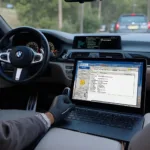Understanding how to use an OBD2 interface is crucial for any car owner or enthusiast. It opens a window into your vehicle’s inner workings, empowering you to diagnose issues, monitor performance, and even customize certain features. This guide provides a step-by-step approach to utilizing the power of your OBD2 interface.
Understanding the OBD2 Interface
The OBD2, or On-Board Diagnostics, interface is a standardized system present in most vehicles manufactured after 1996. It allows external devices, like scanners and code readers, to communicate with your car’s computer and access valuable data. This data ranges from simple diagnostic trouble codes (DTCs) to real-time sensor readings, offering a comprehensive overview of your vehicle’s health and performance. Learning how to use this interface effectively can save you time and money on repairs, improve fuel efficiency, and even enhance your driving experience. You can learn more about specific OBD2 interfaces, like the bluetooth obd2 reader iphone, to connect with your smartphone.
Locating Your OBD2 Port
The first step in using your OBD2 interface is finding the port. It’s typically located under the dashboard, on the driver’s side, near the steering column. Sometimes, it can be hidden behind a panel or near the center console. If you’re having trouble locating it, refer to your vehicle’s owner’s manual.
Choosing the Right OBD2 Scanner
There’s a wide range of OBD2 scanners available, from basic code readers to advanced professional tools. The right one for you depends on your needs and technical expertise. Basic scanners are great for reading and clearing codes, while advanced scanners offer live data streaming, graphing capabilities, and even bi-directional control for testing components. Consider your budget and the level of detail you require when making your selection. Perhaps you’re looking for a specific scanner like the launch obd2 scanner -crp129e.
Connecting the OBD2 Scanner
Once you’ve located the port and chosen your scanner, connecting is simple. Plug the scanner’s connector into the OBD2 port. Make sure the connection is secure. Turn the ignition key to the “on” position (without starting the engine). This powers up the OBD2 system and allows the scanner to communicate with the vehicle’s computer.
Reading and Interpreting Diagnostic Trouble Codes
Most OBD2 scanners are designed to read DTCs. These codes indicate specific issues within your vehicle’s systems. After connecting the scanner, select the “Read Codes” option. The scanner will retrieve any stored codes. Refer to a reliable OBD2 code database or your vehicle’s service manual to interpret the meaning of each code. Understanding what these codes mean is key to proper diagnosis.
Are there specific fuses related to the OBD2 interface? Yes, you can find more information about the obd2 interface fuse on our website.
 Mechanic Reading OBD2 Codes with a Scanner
Mechanic Reading OBD2 Codes with a Scanner
Clearing Diagnostic Trouble Codes
After addressing the issues indicated by the DTCs, you can use the scanner to clear them. This resets the check engine light and allows you to monitor if the issue has been resolved. However, simply clearing codes without fixing the underlying problem is not recommended.
Viewing Live Data
Many OBD2 scanners offer the ability to view live data streams from various sensors. This can be incredibly useful for diagnosing intermittent issues or monitoring specific parameters in real-time. You can observe things like engine RPM, coolant temperature, oxygen sensor readings, and more. This allows for a dynamic understanding of your car’s performance. More information on specific OBD2 fuses, like the obd2 interface fuse 1amp, is available on our website.
Advanced OBD2 Functions
Some scanners provide advanced functions like bi-directional control. This allows you to activate certain components, such as fuel injectors or solenoids, to test their operation. This requires a higher level of technical expertise and should be used with caution. You can even find specialized software to scan obd2 bmw series 7 software windows 8.1.
Conclusion
Knowing how to use an OBD2 interface is a valuable skill for any car owner. It empowers you to take control of your vehicle’s maintenance, diagnose problems effectively, and gain a deeper understanding of its performance. By following these steps and choosing the right tools, you can unlock the full potential of your OBD2 interface.
FAQ
- What is an OBD2 interface?
- Where can I find my OBD2 port?
- What type of OBD2 scanner do I need?
- How do I read and interpret DTCs?
- Can I clear DTCs myself?
- What are live data streams?
- What are some advanced OBD2 functions?
For further assistance, please contact us via WhatsApp: +1(641)206-8880, Email: [email protected] or visit us at 789 Elm Street, San Francisco, CA 94102, USA. We have a 24/7 customer support team available to help you.
